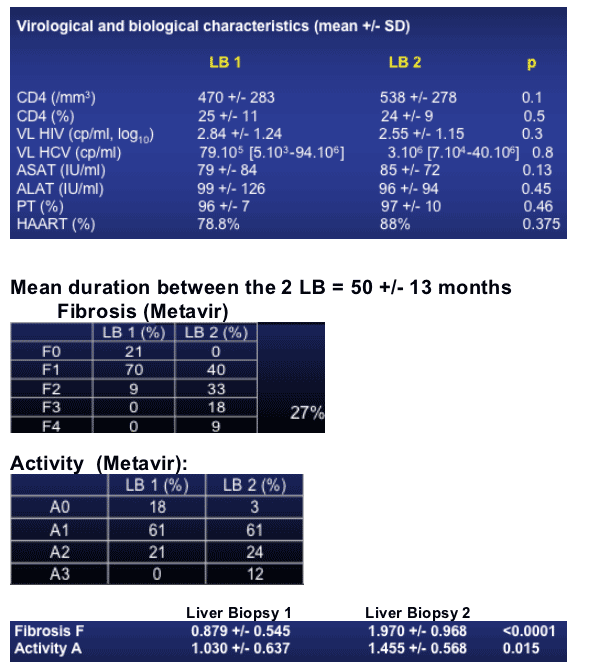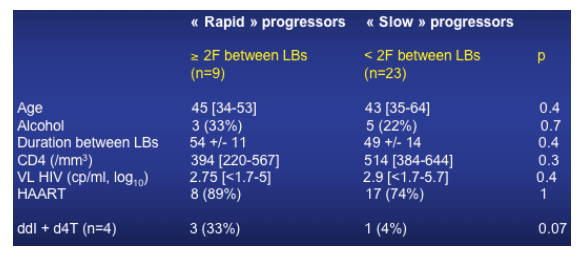 |
 |
 |
| |
Accelerated HCV Progression in HIV: paired liver biopsies
|
| |
| |
Hepatitis C in HIV+ individuals can progress very quickly
Reported by Jules Levin
This study drew much concern at the Coinfection Workshop (Jan 12-14, 2005, Amsterdam). Just last year at CROI Mark sulkowski presented similar findings from his study where paired liver biopsies were performed 2.86 years apart. We know that HCV coinfection is the leading cause of hospitalization and death in HIV except perhaps for AIDS itself. Perhaps the most alarming study at the 2nd Coinfection Workshop was reported by Philippe Bonnard. This study examined fibrosis progression in HCV/HIV coinfected patients, who were not receiving HCV therapy, on the basis of two successive liver biopsies. The study found 28% (9/32) of coinfected patients progressed by at least two fibrosis points between the two biopsies, which were an average of 50 +/- months. The authors recommended evaluating liver fibrosis every 3 years in coinfected patients.
Author Conclusions:
- Mean fibrosis progression rate = 0.25 points/per year
- Some patients (28%) progressed twice as fast (fast progressors) with a 0.5 points/year rate (no predictive factors)
- 1/3 of the patients with no indications of using HCV therapy are found with F3-F4 liver disease stage at liver biopsy 2 only 4 years later. Authors also recommend periodic moniroring for HCC should be studied)
- 50% of the patients who underwent a second liver biopsy began HCV therapy.
- The authors suggested that perhaps non-invasive fibrosis evaluation could permit more frequent monitoring.
Abstract 49
Rapid course of hepatic fibrosis as assessed by two liver biopsies in patients co-infected with HIV and HCV
Philippe Bonnard (Hopital Tenon, Paris, France)
32 coinfected patients at Bonnard’s hospital have been biopsied twice.
Mean age 43 +/- 6 yrs
Retrospectively followed between 1997 and 2000
Prospectively followed from 01/2000 to June 2004
8/32 (25%) used >40g/day alcohol at liver biopsy 1.
Estimated duration of HCV infection (30 patients=13 +/- 5 yrs.
HCV genotype known in 29 patients:
1: n=16 (55%)
2: n=7 (24%)
3. n=6 (21%)


Steatosis:
All five patients with steatosis at LB 1 had grade 0 steatosis.
Not sufficiently numerous to study a relationship between steatosis and fibrosis...
Protease inhibitors:
-- 80% of the patients were on HAART at the time of LB 1,
90% at the time of LB 2
-- Unable to confirm the protective action of HAART or PI...
Finally, how many patients began an anti-HCV treatment
with the second LB ?
n= 15 (47%)
AUTHOR DISCUSSION
Annual fibrosis progression rate = 0.25 point/year/patient
Some patients (28%) are "rapid" progressors = 0.51 point / year...
No predictive factors identified in this study...
Patients undergoing LB are not immunocompromised:
(CD4 = 470/mm3 at LB1 and 538/mm3 at LB 2)
- Patients immunocompromised are less biopsed than others
(Patients with CD4<200/mm3 = 22% at LB 1, 12% at LB 2)
- Despite high CD4, liver fibrosis is a rapid processus
- If CD4 play a protective role, liver fibrosis could progress faster in
immunocompromised patients ?
2/3 of the patients worsened their liver fibrosis, 1/3 entered the extensive fibrosis stages (F3-F4), underlining the usefulness of evaluating liver fibrosis within three years.
|
|
| |
| |
|
 |
 |
|
|